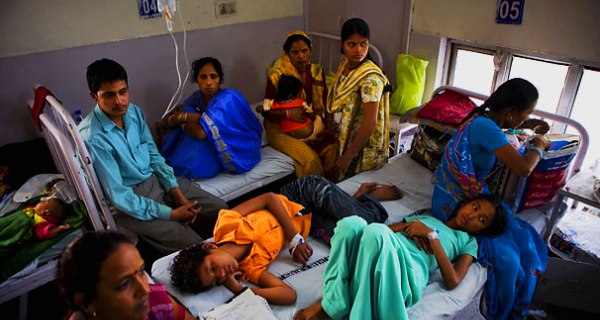 GENEVA: India and many other southeast Asian countries need to improve their record on public health care, the WHO said here as it warned that the world will fall short in achieving the UN’s Millennium Development Goals (MDGs) on many indicators by the end of this year.
GENEVA: India and many other southeast Asian countries need to improve their record on public health care, the WHO said here as it warned that the world will fall short in achieving the UN’s Millennium Development Goals (MDGs) on many indicators by the end of this year.
“Its been incredible progress in the past 25 years particularly in the fight against the epidemics of HIV, TB and malaria,” said Ties Boerma, Director, Health Statistics and Information System, World Health Organization (WHO) releasing the World Health Statistics 2015 report.
“Also, increase in safe drinking water. Much progress in child malnutrition, maternal and child mortality but those are still quite far from the targets we set for the MDGs. We are not likely to achieve it by the end of this year,” he said.
Speaking of India’s slow progress, Boerma said, “There is less progress for family planning, ante-natal care indicators.
It is a mixed picture. It is a progress picture but not as spectacular as in western Pacific”.
“One particular area is measles immunization where India has lagged behind in achieving good coverage and that hopefully will change in the future,” said Colin Mathers, Coordinator, Department of Mortality & Burden of Disease, WHO.
Measles immunization coverage among one-year-olds was 74 per cent in India in 2013 which is one of the lowest in the Southeast Asian region.
India has seen only a 58 per cent reduction in under-five mortality rate between 1990 and 2013, again one of the lowest reductions in the region, ahead only of North Korea, Myanmar and Sri Lanka, Mathers said.
There is a 21 per cent unmet need for family planning and only a 22 per cent reduction in proportion to population in access to improved sanitation in India between 1990 and 2012, as per MDG targets.
Some of the indicators where India has met the MDG targets or is on track are reduction in HIV incidence between 2001 and 2013 (57 per cent), mortality rate for tuberculosis between 1990 and 2013 (50 per cent), increase in access to safe drinking water between 1990 and 2012 (77 per cent), he said.
The World Health Statistics report is released annually ahead of the World Health Assembly which is due to begin on May 18 in Geneva.
“Life expectancy is continuing to increase at the top end and also at the bottom end. The astonishing news is global life expectancy is increasing at the same rate as life expectancy in advanced countries,” Mathers said.
Life expectancy at birth has increased 6 years for both men and women since 1990 and stands at 71 years. While life expectancy at 60 has also increased and stands at 80 years.
“It is because people who live to be 60 have already avoided all the causes of death in infancy, childhood and middle age,” said Mathers.
The progress in Southeast Asia has been the slowest in meeting the MDG targets among the WHO regions.
“Big progress in western Pacific. And of course, China’s progress has been instrumental there. Also, in the Americas huge progress has been made. And almost the same extent in the European region which stretches out to the central Asian republics,” said Boerma.
“Then we come to the regions that are slower which includes Southeast Asia including India and Indonesia. The east Mediterranean region and African region…not for all the indicators but those are the three regions that need major attention to catch up,” he added.
The biggest achievement in meeting MDG targets globally was in HIV incidence followed by child mortality.
The world has begun to reverse the spread of HIV, with new infections reported in 2013 of 2.1 million people, down from 3.4 million in 2001.
Since 1990, child deaths have almost halved – falling from an estimated 90 deaths per 1,000 live births to 46 deaths per 1,000 live births in 2013, saving 6 million children below five in the last 25 years, according to the report.
The number of women who died due to complications during pregnancy and childbirth has almost halved between 1990 and 2013.
This rate of decrease won’t be enough to achieve the targeted reduction of 75 per cent by the end of this year.
“Less progress has been achieved in maternal mortality.
The target was three quarters less so quite farther off there,” said Boerma.
“I think it’s crystal clear to everyone that there is a huge agenda that needs to be addressed in the coming 15 years as part of the Sustainable Development Goals (SDGs),” he said.
The world is unlikely to meet the MDG target on access to basic sanitation. Around 1 billion people have no access to basic sanitation and are forced to defecate in open spaces such as fields and near water sources, the WHO said. -PTI






